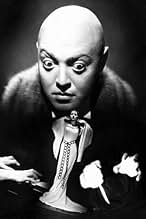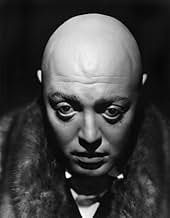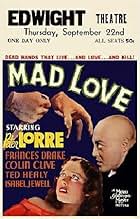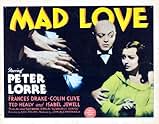CALIFICACIÓN DE IMDb
7.2/10
6.2 k
TU CALIFICACIÓN
Agrega una trama en tu idiomaIn Paris, a demented surgeon's obsession with a British actress leads him to secretly replace her concert-pianist husband's mangled hands with those of a guillotined murderer with a gift for... Leer todoIn Paris, a demented surgeon's obsession with a British actress leads him to secretly replace her concert-pianist husband's mangled hands with those of a guillotined murderer with a gift for knife-throwing.In Paris, a demented surgeon's obsession with a British actress leads him to secretly replace her concert-pianist husband's mangled hands with those of a guillotined murderer with a gift for knife-throwing.
- Dirección
- Guionistas
- Elenco
- Premios
- 1 nominación en total
Sara Haden
- Marie
- (as Sarah Haden)
George Davis
- Chauffeur
- (escenas eliminadas)
Billy Dooley
- Undetermined Role
- (escenas eliminadas)
Harold Huber
- Thief
- (escenas eliminadas)
Isabel Jewell
- Marianne
- (escenas eliminadas)
Leo White
- Undetermined Role
- (escenas eliminadas)
Sam Ash
- Detective Arresting Stephen
- (sin créditos)
Hooper Atchley
- Train Conductor
- (sin créditos)
Agostino Borgato
- Stage Doorman
- (sin créditos)
Maurice Brierre
- Taxi Driver
- (sin créditos)
Opiniones destacadas
This adaptation of Renard's The Hands of Orlac is quite good, yet a bit on the stagy side. It is one of Peter Lorre's early films and his first for Hollywood. Lorre is quite good, and almost sympathetic in a way, as a surgeon who has hopelessly fallen in love with the wife of a great pianist. Colin Clive of Frankenstein fame plays the musician, and Frances Drake plays his rather annoying, overacting wife. The visuals of the film are first-rate, as it was directed by great cameraman Karl Freund. Ted Healy adds some unnecessary comic relief. What I liked best about the film was the staging of the story against some beautiful expressionistic sets and Freunds expressive camerawork.
Excellent, morbid story of a brilliant sureon's (Lorre) obsessive, fetishistic love for a Grand Guignol style actress. The early scenes are perhaps the best film evocative of actual Grand Guignol sadefests. Lorre manages to procure a perfect waxen statue of his love object, thus introducing doppleganger horror, a relatively rare treat in American horror. The main plot focuses on Lorre's attempt to implicate Drake's husband in a series of murders by convincing him that the hands he grafted for him are acting of their own will (as in "Hands of Orlac"). Many subtle moments (which critics have not credited the film for), some garishly out-of-place slapstick humor is the only negative aspect. Fantastic photography.
This is Lorre's entry into classic horror stardom: Karloff has his Frankenstein monster, Lugosi has Dracula (forever, folks), Chaney Jr. has the wolfman, and Lorre's got this lesser-known but equally classic film to recommend him as one of the major horror stars of the classic era. This film represents MGM's entry into the early 30s horror film sweepstakes as well, and they did well to associate themselves with solid hands like Freund's and Lorre's. Hands..... hmmmmm unintended pun. Anyway, if anyone out there is a fan of classic horror films and has not yet seen this one, put it at the top of your list.
This is Lorre's entry into classic horror stardom: Karloff has his Frankenstein monster, Lugosi has Dracula (forever, folks), Chaney Jr. has the wolfman, and Lorre's got this lesser-known but equally classic film to recommend him as one of the major horror stars of the classic era. This film represents MGM's entry into the early 30s horror film sweepstakes as well, and they did well to associate themselves with solid hands like Freund's and Lorre's. Hands..... hmmmmm unintended pun. Anyway, if anyone out there is a fan of classic horror films and has not yet seen this one, put it at the top of your list.
When acclaimed concert pianist Stephen Orlac (Colin Clive) is in a terrible accident, his hands are crushed and must be amputated. His wife Yvonne (Frances Drake) appeals to the brilliant Dr. Gogol (Peter Lorre) to use his surgical genius to save Stephen's hands. Gogol accepts as he's madly in love with Yvonne, but instead of saving Stephen's hands, he replaces them with those from an executed murderer.
This was Lorre's first American film, and one of his very best performances ever. He's at once menacingly creepy and pathetically sympathetic, a brilliant mind trapped in an ugly body, deeply in love with someone he can never have. I also really like Drake as the object of affection, beautiful, classy and empathetic. Lorre's costume late in the film is a visual highlight of 1930's film, and the moody cinematography is excellent. Recommended.
This was Lorre's first American film, and one of his very best performances ever. He's at once menacingly creepy and pathetically sympathetic, a brilliant mind trapped in an ugly body, deeply in love with someone he can never have. I also really like Drake as the object of affection, beautiful, classy and empathetic. Lorre's costume late in the film is a visual highlight of 1930's film, and the moody cinematography is excellent. Recommended.
German actor Peter Lorre made his American film debut in "Mad Love," which I believe was an MGM release and proved to be competition for some of the popular Universal Horror films of the time. Peter Lorre had made his epic debut with 1930's "M," in which Peter amazingly played a child-killer under director Fritz Lang. Peter is a demonic performer if their ever was one, and every memorable scene in this film has Peter's lonely mad doctor character at the helm. Peter is very much in love with a stage actress who is preparing to marry a popular pianist, and all of this gets in the way of Peter's fantasy to have the woman all for himself. A train accident occurs, which leaves the pianist with little hope, but it is Peter the doctor who goes about replacing the pianist's hands with those of a dead criminal, whom Peter himself had watched the beheading of a few days before the train accident. Things take a very silly turn, when the hands somehow take over the very personality of the pianist, and Peter's mad doctor plays the innocent with the pianist, while at the time, telling his actress girlfriend that he is simply mad and that she should stay far and away from him. I would rather not mention how the story unfolds, because that would ruin the good fun for those who have yet to watch this feature, but I must admit that the ending is very funny in a sad way, and there's so much going on with Peter's sanity throughout the film. Worth seeing for a variety of different reasons, so watch it.
Dr. Gogol (Peter Lorre) is a brilliant surgeon who is obsessed with actress Yvonne Orlac (Francis Drake). She tells him she is leaving the stage to be a full time wife to her husband Stephen Orlac (Colin Clive), a concert pianist. Gogol is crushed. Stephen Orlac loses his hands in a train wreck.
At the request of Yvonne, Orlac grafts on a new pair of hands to Stephen. Unfortunately, they happen to be the hands of Rollo, an executed murderer who loved throwing knives. It seems the hands have a life of their own--Stephen can't play the piano anymore but can throw knives accurately and he has a desire to kill. He slowly starts to go crazy. Gogol again tells Yvonne that he loves her. She rejects him and Gogol cracks. He sets out to drive Stephen mad--and drive Yvonne into his arms.
The plot is silly but it still works. Anyways, the film isn't respected for its plot--it's because of Lorre and the sets. The sets in this film are huge, designed very strangely and add to the weirdness of the plot. They're all dimly lit giving the film a dark, depressing look. The acting is almost all good. Drake is just beautiful and perfect as the suffering wife. Clive is way too serious and looks horrible--sadly the man suffered from alcoholism...and it shows. Lorre is just superb as Gogol. He's very severe looking with his shaved head. You see him start out as kindly but obsessed and slowly slip into madness. Also there's a genuinely terrifying meeting Orlac has with Gogol (disguised as someone else) in a hotel. And director Karl Fruend throws in an amusing in joke--someone's repeats the "It went for a little walk" line from his "The Mummy" (1932)! The only real debit is the unnecessary "comic" relief from Ted Healy and an alcoholic landlady (sorry, but alcoholism isn't funny).
This is still mostly unknown more than 60 years after its release. Why? It bombed badly when it came out, was too grim for most people and it almost never pops up on TV. That's a shame--it's one of the best horror films to come out in the 1930s. See this if you get a chance--it's only 70 minutes and it's well worth it! One of Lorre's best performances.
At the request of Yvonne, Orlac grafts on a new pair of hands to Stephen. Unfortunately, they happen to be the hands of Rollo, an executed murderer who loved throwing knives. It seems the hands have a life of their own--Stephen can't play the piano anymore but can throw knives accurately and he has a desire to kill. He slowly starts to go crazy. Gogol again tells Yvonne that he loves her. She rejects him and Gogol cracks. He sets out to drive Stephen mad--and drive Yvonne into his arms.
The plot is silly but it still works. Anyways, the film isn't respected for its plot--it's because of Lorre and the sets. The sets in this film are huge, designed very strangely and add to the weirdness of the plot. They're all dimly lit giving the film a dark, depressing look. The acting is almost all good. Drake is just beautiful and perfect as the suffering wife. Clive is way too serious and looks horrible--sadly the man suffered from alcoholism...and it shows. Lorre is just superb as Gogol. He's very severe looking with his shaved head. You see him start out as kindly but obsessed and slowly slip into madness. Also there's a genuinely terrifying meeting Orlac has with Gogol (disguised as someone else) in a hotel. And director Karl Fruend throws in an amusing in joke--someone's repeats the "It went for a little walk" line from his "The Mummy" (1932)! The only real debit is the unnecessary "comic" relief from Ted Healy and an alcoholic landlady (sorry, but alcoholism isn't funny).
This is still mostly unknown more than 60 years after its release. Why? It bombed badly when it came out, was too grim for most people and it almost never pops up on TV. That's a shame--it's one of the best horror films to come out in the 1930s. See this if you get a chance--it's only 70 minutes and it's well worth it! One of Lorre's best performances.
¿Sabías que…?
- TriviaCharles Chaplin called Lorre the screen's best actor after seeing his performance in "Mad Love."
- ErroresThroughout the picture, the wax figure moves slightly whenever Frances Drake is subbing for the actual statue. Most noticeable when the bird lands on her shoulder, making the "lifeless" statue sway.
- Citas
Françoise, Gogol's Housekeeper: [referring to the wax figure of Yvonne] It went out for a little walk!
- Créditos curiososAt the end of the opening credits, the titles are painted on a glass window pane that is broken by a fist punching through it.
- Versiones alternativasPhil Hardy's The Overlook Film Encyclopedia: Science Fiction (p. 94) states that there is an 85-minute version of the film, although he provides no details about this.
- ConexionesEdited into The History of the Hands (2016)
Selecciones populares
Inicia sesión para calificar y agrega a la lista de videos para obtener recomendaciones personalizadas
- How long is Mad Love?Con tecnología de Alexa
Detalles
Taquilla
- Presupuesto
- USD 257,502 (estimado)
- Tiempo de ejecución1 hora 8 minutos
- Color
- Relación de aspecto
- 1.37 : 1
Contribuir a esta página
Sugiere una edición o agrega el contenido que falta






































